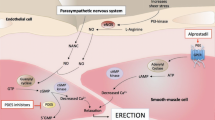Abstract
Aim
To determine the effectiveness of transdermal electromotive administration (TEA) of verapamil and dexamethasone in the treatment of Peyronie’s disease (PD).
Method
Totally, 51 patients with PD were prospectively included in the study. All patients were evaluated by history, subjective score scales, physical examination, photographs, and penile USG, before and after therapy. All patients were treated with TEA of the combination of verapamil and dexamethasone. The treatment plan included a total of 20 sessions (at 3-day intervals for a period of 2 months), each with a duration of 20 min. At the end of the study, improvements in penile plaques, penile deviation, pain on erection, and erectile dysfunction were determined.
Results
The findings in 41 of the 51 patients were eligible to present. Median patient age was 52 years. Median duration of disease at presentation was 8 months. Remarkable reduction in palpable plaques and in penile angulation was observed in 10 patients (24%) and 11 (26%) patients, respectively. There were significant decreases in median plaque volume from 72 mm2 to 45 mm2 (P < 0.001), and in median penile angulation from 25º to 15º (P < 0.001). Impaired sexual activity and pain on erection had completely resolved in 11 (55%) patients and in 16 (80%), respectively.
Conclusion
The results of our study have shown that TEA of the combination of verapamil and dexamethasone is a more effective therapy for improving subjective symptoms rather than objective symptoms. Therefore, we think that this treatment can be individualized according to the clinical features of PD patients.
Similar content being viewed by others
References
Tefekli A, Kandirali E, Erol H, Alp T, Köksal T, Kadioğlu A (2001) Peyronie’s disease in men under age 40: characteristics and outcome. Int J Impot Res 13(1):18–23
Mulhall JP, Creech SD, Boorjian SA (2004) Subjective and objective analysis of the prevalence of Peyronie’s disease in a population of men presenting for prostate cancer screening. J Urol 171(6 Pt 1):2350–2353
Schwarzer U, Sommer F, Klotz T, Braun M, Reifenrath B, Engelmann U (2001) The prevalence of Peyronie’s disease: results of a large survey. BJU Int 88(7):727–730
Hellstrom WJ, Bivalacqua TJ (2000) Peyronie’s disease: etiology, medical, and surgical therapy. J Androl 21(3):347–354
Devine CJ, Somers KD, Ladaga LE (1991) Peyronie’s disease: pathophysiology. Prog Clin Biol Res 370:355–358
Levine LA, Merrick PF, Lee RC (1994) Intralesional verapamil injection for the treatment of Peyronie’s disease. J Urol 151(6):1522–1524
Devine CJ, Somers KD, Jordan SG, Schlossberg SM (1997) Proposal: trauma as the cause of the Peyronie’s lesion. J Urol 157:285–290
Jarow JP, Lowe FC (1997) Penile trauma: an etiologic factor in Peyronie’s disease and erectile dysfunction. J Urol 158:1388–1390
Van de Water L (1997) Mechanisms by which fibrin and fibronectin appear in healing wounds: implications for Peyronie’s disease. J Urol 157:306–310
Bour H (1984) Current status of vitamin E. Rev Prat 34:1270–1271
Ralph DJ, Brooks MD, Bottazzo GF, Pryor JP (1992) The treatment of Peyronie’s disease with tamoxifen. Br J Urol 70(6):648–651
Akkus E, Carrier S, Rehman J, Breza J, Kadioglu A, Lue TF (1994) Is colchicine effective in Peyronie’s disease? A pilot study. Urology 44(2):291–295
Carson CC (1997) Potassium para-aminobenzoate for the treatment of Peyronie’s disease: is it effective? Tech Urol 3:135–139
Fitkin J, Ho GT (1999) Peyronie’s disease: current management. Am Fam Physician 60(2):549–552
Weidner W, Hauck EW, Schnitker J (2005) Peyronie’s Disease Study Group of Andrological Group of German Urologists. Potassium paraaminobenzoate (POTABA) in the treatment of Peyronie’s disease: a prospective, placebo-controlled, randomized study. Eur Urol 47(4):530–535
Gelbard MK, Dorey F, James K (1990) The natural history of Peyronie’s disease. J Urol 144:1376–1379
Tunuguntla HS (2001) Management of Peyronie’s disease—a review. World J Urol 19:244–250
Levine LA (1997) Treatment of Peyronie’s disease with intralesional verapamil injection. J Urol 158:1395–1399
Rehman J, Benet A, Melman A (1998) Use of intralesional verapamil to dissolve Peyronie’s disease plaque: a long-term single-blind study. Urology 51:620–626
Levine LA, Goldman KE, Greenfield JM (2002) Experience with intraplaque injection of verapamil for Peyronie’s disease. J Urol 168(2):621–625
Hellstrom WJ, Kendirci M, Matern R (2006) Single-blind, multicenter, placebo controlled paralel study to assess the safety and efficacy of intralesional interferon alpha-2B for minimally invasive treatment for Peyronie’s disease. J Urol 176(1):394–398
Gelbard MK, James K, Riach P, Dorey F (1993) Collagenase versus placebo in the treatment of Peyronie’s disease: a double-blind study. J Urol 149(1):56–58
Ludwig G (1991) Evaluation of conservative therapeutic approaches to Peyronie’s disease (fibrotic induration of the penis). Urol Int 47(4):236–239
Riedl CR, Plas E, Engelhardt P, Daha K, Pflüger H (2000) Iontophoresis for treatment of Peyronie’s disease. J Urol 163(1):95–99
Montorsi F, Salonia A, Guazzoni G (2000) Transdermal electromotive multi-drug administration for Peyronie’s disease: preliminary results. J Androl 21:85–90
Di Stasi SM, Giannantoni A, Capelli G (2003) Transdermal electromotive administration of verapamil and dexamethasone for Peyronie’s disease. BJU Int 91:825–829
Di Stasi SM, Giannantoni A, Stephen RL (2004) A prospective, randomized study using transdermal electromotive administration of verapamil and dexamethasone for Peyronie’s disease. J Urol 171:1605–1608
Greenfield JM, Shah SJ, Levine LA (2007) Verapamil versus saline in electromotive drug administration for Peyronie’s disease: a double-blind, placebo controlled trial. J Urol 177(3):972–975
Mulhall JP, Anderson MS, Lubrano T, Shankey TV (2002) Peyronie’s disease cell culture models: phenotypic, genotypic and functional analyses. Int J Impot Res 14(5):397–405
Martin DJ, Badwan K, Parker M, Mulhall JP (2002) Transdermal application of verapamil gel to the penile shaft fails to infiltrate the tunica albuginea. J Urol 168(6):2483–2485
Kadioglu A, Tefekli A, Erol B, Oktar T, Tunc M, Tellaloglu S (2002) A retrospective review of 307 men with Peyronie’s disease. J Urol 168(3):1075–1079
Author information
Authors and Affiliations
Corresponding author
Rights and permissions
About this article
Cite this article
Tuygun, C., Ozok, U.H., Gucuk, A. et al. The effectiveness of transdermal electromotive administration with verapamil and dexamethasone in the treatment of Peyronie’s disease. Int Urol Nephrol 41, 113–118 (2009). https://doi.org/10.1007/s11255-008-9408-x
Received:
Accepted:
Published:
Issue Date:
DOI: https://doi.org/10.1007/s11255-008-9408-x




